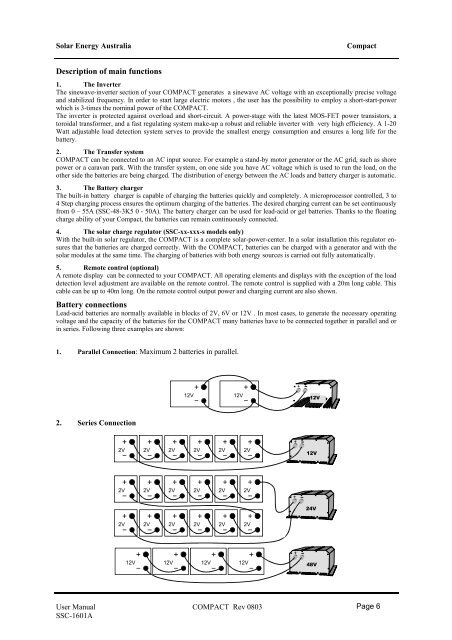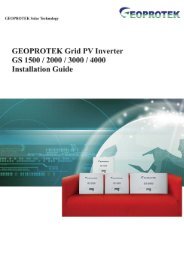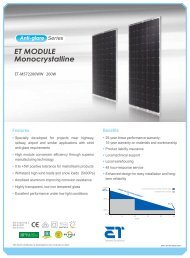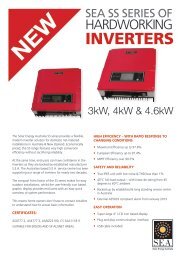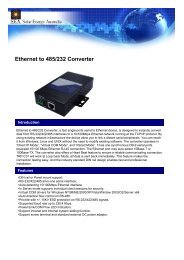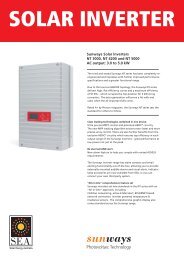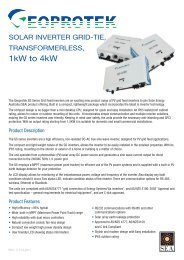Compact Manual 0303 - Solar Energy Australia
Compact Manual 0303 - Solar Energy Australia
Compact Manual 0303 - Solar Energy Australia
You also want an ePaper? Increase the reach of your titles
YUMPU automatically turns print PDFs into web optimized ePapers that Google loves.
<strong>Solar</strong> <strong>Energy</strong> <strong>Australia</strong><br />
<strong>Compact</strong><br />
Description of main functions<br />
1. The Inverter<br />
The sinewave-inverter section of your COMPACT generates a sinewave AC voltage with an exceptionally precise voltage<br />
and stabilized frequency. In order to start large electric motors , the user has the possibility to employ a short-start-power<br />
which is 3-times the nominal power of the COMPACT.<br />
The inverter is protected against overload and short-circuit. A power-stage with the latest MOS-FET power transistors, a<br />
toroidal transformer, and a fast regulating system make-up a robust and reliable inverter with very high efficiency. A 1-20<br />
Watt adjustable load detection system serves to provide the smallest energy consumption and ensures a long life for the<br />
battery.<br />
2. The Transfer system<br />
COMPACT can be connected to an AC input source. For example a stand-by motor generator or the AC grid, such as shore<br />
power or a caravan park. With the transfer system, on one side you have AC voltage which is used to run the load, on the<br />
other side the batteries are being charged. The distribution of energy between the AC loads and battery charger is automatic.<br />
3. The Battery charger<br />
The built-in battery charger is capable of charging the batteries quickly and completely. A microprocessor controlled, 3 to<br />
4 Step charging process ensures the optimum charging of the batteries. The desired charging current can be set continuously<br />
from 0 – 55A (SSC-48-3K5 0 - 50A). The battery charger can be used for lead-acid or gel batteries. Thanks to the floating<br />
charge ability of your <strong>Compact</strong>, the batteries can remain continuously connected.<br />
4. The solar charge regulator (SSC-xx-xxx-s models only)<br />
With the built-in solar regulator, the COMPACT is a complete solar-power-center. In a solar installation this regulator ensures<br />
that the batteries are charged correctly. With the COMPACT, batteries can be charged with a generator and with the<br />
solar modules at the same time. The charging of batteries with both energy sources is carried out fully automatically.<br />
5. Remote control (optional)<br />
A remote display can be connected to your COMPACT. All operating elements and displays with the exception of the load<br />
detection level adjustment are available on the remote control. The remote control is supplied with a 20m long cable. This<br />
cable can be up to 40m long. On the remote control output power and charging current are also shown.<br />
Battery connections<br />
Lead-acid batteries are normally available in blocks of 2V, 6V or 12V . In most cases, to generate the necessary operating<br />
voltage and the capacity of the batteries for the COMPACT many batteries have to be connected together in parallel and or<br />
in series. Following three examples are shown:<br />
1. Parallel Connection: Maximum 2 batteries in parallel.<br />
12V<br />
12V<br />
12V<br />
2. Series Connection<br />
2V 2V 2V 2V 2V 2V<br />
12V<br />
2V 2V 2V 2V 2V 2V<br />
24V<br />
2V 2V 2V 2V 2V 2V<br />
12V 12V 12V 12V<br />
48V<br />
User <strong>Manual</strong> COMPACT Rev 0803<br />
SSC-1601A<br />
Page 6


